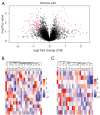Mechanism of the Huangguoshu waterfall forest environment's promotive effect on human health in Guizhou, China
- PMID: 36110995
- PMCID: PMC9469133
- DOI: 10.21037/atm-22-3787
Mechanism of the Huangguoshu waterfall forest environment's promotive effect on human health in Guizhou, China
Abstract
Background: The aim of this study was to investigate the specific mechanisms underlying the human health-promoting effects of the forest environment at Huangguoshu Falls, Guizhou, China.
Methods: Ninety-five participants were recruited and an eye tracker was used to record fixation and sweep indices. A questionnaire was also used to evaluate the effects of different subject environments on human emotions, perceived recovery and preferences. Thereafter, 24 participants with chronic fatigue syndrome (CFS) were recruited and the participants' fatigue and stress-related scale indices and inflammatory factor levels were examined. Serum metabolites of the participants under different time waterfall forest interventions were detected by ultra performance liquid chromatography-quadrupole-time of flight mass spectrometry (UHPLC-Q/TOF-MS).
Results: Eye tracking paradigm analysis showed that the "waterfall" element was the most interesting element for participants and that the "charm" of the waterfall forest environment could be well perceived by participants. Scores on the Fatigue Scale, Anxiety Scale and Depression Scale decreased as the duration of treatment in the waterfall forest environment increased. Levels of inflammatory factors decreased after treatment in the waterfall forest environment. At the same time the level of antioxidants, represented by L-ascorbic acid, increased significantly.
Conclusions: The charm of the Huangguoshu waterfall scenery could be perceived by the participants and have a positive modulating effect on mood and cognitive function. In addition, the unique mixture of negative oxygen ions in this environment can increase the content of endogenous antioxidants and balance the metabolism of choline and amino acids.
Keywords: Huangguoshu waterfall; chronic fatigue syndrome (CFS); healing environment; natural therapy; waterfall forest environment.
2022 Annals of Translational Medicine. All rights reserved.
Conflict of interest statement
Conflicts of Interest: All authors have completed the ICMJE uniform disclosure form (available at https://atm.amegroups.com/article/view/10.21037/atm-22-3787/coif). The authors have no conflicts of interest to declare.
Figures

















Similar articles
-
Effects of short-term waterfall forest aerosol air exposure on rat lung proteomics.Ann Transl Med. 2022 Nov;10(22):1223. doi: 10.21037/atm-22-4813. Ann Transl Med. 2022. PMID: 36544689 Free PMC article.
-
Waterfall Forest Environment Regulates Chronic Stress via the NOX4/ROS/NF-κB Signaling Pathway.Front Neurol. 2021 Mar 18;12:619728. doi: 10.3389/fneur.2021.619728. eCollection 2021. Front Neurol. 2021. PMID: 33868142 Free PMC article.
-
Miao Shen.Angew Chem Int Ed Engl. 2021 Dec 20;60(52):26892. doi: 10.1002/anie.202114256. Epub 2021 Nov 2. Angew Chem Int Ed Engl. 2021. PMID: 34726821
-
[Effect of forest bathing (shinrin-yoku) on human health: A review of the literature].Sante Publique. 2019 May 13;S1(HS):135-143. doi: 10.3917/spub.190.0135. Sante Publique. 2019. PMID: 31210473 Review. French.
-
Screening of synthetic PDE-5 inhibitors and their analogues as adulterants: analytical techniques and challenges.J Pharm Biomed Anal. 2014 Jan;87:176-90. doi: 10.1016/j.jpba.2013.04.037. Epub 2013 May 6. J Pharm Biomed Anal. 2014. PMID: 23721687 Review.
References
LinkOut - more resources
Full Text Sources
